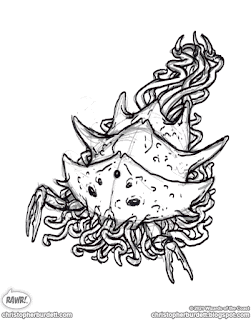Today, I am happy to share the process and steps that went into one of my two illustrations in the recently released Dungeons & Dragons supplement, Van Richten's Guide to Ravenloft. For this installment, I am sharing the Carrion Stalker. The Carrion Stalker was described as an alien horseshoe crab, and that is definitely in my wheelhouse. Here is the final painting for the Carrion Stalker.

When I was working on this piece, I was unaware that it had any connection to the Carrion Crawler. I thought it was a completely new creature that originated in space. As I said above, it was described to me as an alien horseshoe crab. Well, let me be clear, an alien horseshoe crab that sat upon a mass of tentacles and pulled itself along by pincer claws. This all seemed like a perfectly normal day in the Realms, so I got to work on some thumbnails. I grew up around horseshoe crabs, so I am more than familiar with them. I did not look at any reference for this piece. Instead, I wanted to play with shapes and forms and make something cool. I was asked to do an additional design of what the underside looked like. It needed to have a large mouth ringed in teeth at the center of the tentacle mass. In addition to the final painting, I would be providing a pencil drawing of the underside view. Here are the thumbnails I supplied for the Carrion Stalker.


Here is where things went a little wrong for me, but not in the way you might think. The drawing was approved, and I was all set to start on the painting. The only issue was that I forgot to scan the drawing when I was finished with line art. While I am now finishing the drawings with shading and texture to have a more pleasing end piece and a lighting guide, I still use the line art of the drawing as the base of the painting. The technique to prep the drawing for the painting stage works best with line art, but not as much with a rendered drawing. Not having the line art slowed me down slightly when I started the painting since I couldn't separate which mass of grays was tentacles or shell. Here is a look at the painting coming together.
In the end, it was a straightforward painting, even with my goof up with the line art scan. Once I got into the painting a little and began to define forms, the gray masses started to take shape, and it was smooth sailing. You might notice that near the end, one of the lateral spikes dramatically increases in size. I had reduced it while I was drawing because, at the time, it looked too big. When I was nearing the end of the painting, it was obvious to me that I had reduced the spike too much and it needed to be inlarged. A easy fix, but one I had thought I already addressed.
Now for that underside view I mentioned before. I created the drawing based on the approved thumbnail. The only issue was that at some point along the line it was no longer approved. There were some concerns about the shape of the mouth and after turning in the finsihed drawing I was asked to make the mouth horizontal. Anotomically, I don't think a horizontal mouth works as well, but I was aksed to change it, so I changed it. Rather than attempting to edit the drawing either traditoanlly on digitally I redrew the entire piece over again with the updated mouth. Why have one drawing when you can have two? Here are the two versions of the underside view of the Carrion Stalker.


The painting was approved without revisions and once the second underside drawing was submitted that too was approved. I am pleased with how this one turned out. I wanted to do acheive a specific look and feel for the tentacles and I think I suceeded. Here again is the final painting for the Carrion Stalker.
That's all for another exciting Wednesday on the blog. See you back here on Friday! Until then...




No comments:
Post a Comment